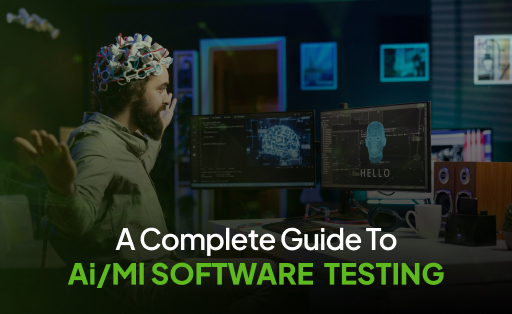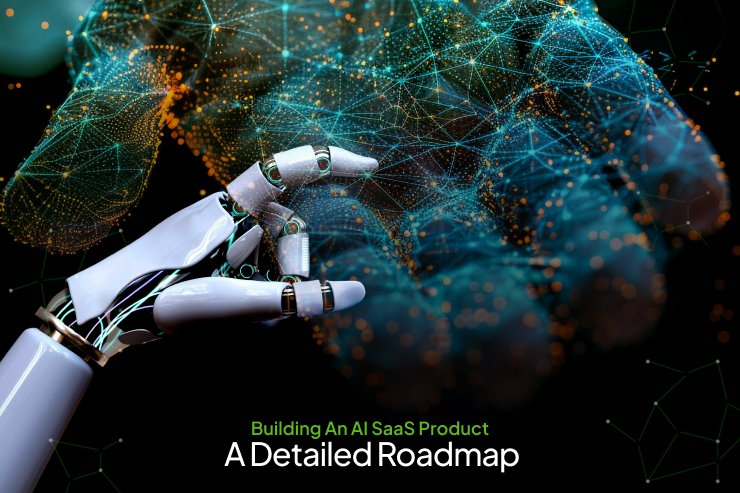A Complete Guide To AI/ML Software Testing Software Development

Artificial Intelligence (AI) and Machine Learning (ML) are two of the most exhilarating and quickly evolving fields in technology nowadays. These days, you may have heard a lot of discussion regarding artificial intelligence and machine learning. Every now and then, the discussion about it makes us feel overwhelmed, and at times, we find ourselves really in on it.
Undoubtedly, Artificial Intelligence (AI) and Machine Learning (ML) have transformed the way we think about software testing. Ever since the institution of the disruptive AI-powered language model ChatGPT, a vast range of AI-augmented technologies have also developed, and the profits they carried surely can’t be overlooked.
So whether you are a beginner or just curious about what AI and ML are all about, this blog is for you. Keep reading!
What is software testing?
The software testing market was estimated at USD 51.8 billion in 2023 and is anticipated to grow at a CAGR of over 7% from 2024 to 2032, determined by major companies’ maximized product launches and improvements.
Software testing is a significant process in the software development lifespan, which includes authenticating and confirming that a software application is free of bugs, caters to the technical requirements set by its design and development, and pleases user demands proficiently.
This process ensures the application can manage all exceptional and boundary cases, delivering a robust and consistent user experience. By methodically recognizing and fixing issues, software testing assists in delivering high-quality software that functions as anticipated in different situations.
The practice of software testing aims not only at detecting faults in the existing software but also at finding measures to enhance the software in terms of productivity, precision, and usefulness.
What is AI/ML?
AI is a computer system that can execute tasks usually requiring human intelligence. These tasks might involve understanding natural language, identifying patterns, making decisions, or solving problems. For software testers, AI can automate monotonous tasks, analyze data to find patterns and insights, and even make forecasts regarding potential issues or developments in the software.
ML is a subgroup of AI that emphasizes building systems that can learn from data. As opposed to explicitly programming rules, ML algorithms can learn from instances and data patterns to enhance their performance over time. For software testers, ML can assist in several ways, including automatically generating test scripts, classifying anomalies in test results, or adapting testing strategies based on the evolving landscape of the software.
AI and ML in Software Testing
AI/ML in software testing refers to the incorporation of Artificial Intelligence and Machine Learning technologies into several phases and facets of software testing to improve it. With the help of AI/ML, software testers can now boost their testing by employing the human-level decision-making capabilities of these technologies.
How is AI/ML used in software testing?
As per the State of Software Quality Report 2024, test case generation is the most common application of AI for both manual testing and automation testing, succeeded by test data generation. You can download the report for up-to-date insights into the industry.
AI/ML can be used in so many ways to supercharge our software testing, and the key to exposing those competencies is knowing what these technologies can possibly do and then finding creative ways to integrate them into your daily testing tasks. There are three key approaches when selecting an AI/ML system to integrate into your software testing, including:
- A durable and resource-intensive move by building your own AI personalized to the requirements of the organisation.
- Leveraging foundation models through APIs or open models
- Employing off-the-shelf tools with built-in AI features for testing
The closing decision on which approach to use relies on the vision of the whole organization and the team. Whichever you select, there are generally 5 areas an AI/ML system can provide the most:
-
Automated Smart Test Case Generation
ChatGPT has significantly influenced the software engineering field, demanding newcomers to improve their skills to meet growing requirements. ChatGPT can be used to write test cases in the software testing field, but it’s not a one-size-fits-all solution. Traditional automated test scripts require constant maintenance to understand updated code, which is challenging for automation testers in the dynamic, agile environment. The integration of AI/ML in software testing offers a simple language prompts that help crafting tests for precise scenarios and accelerate test maintenance work.
-
Test Case Recommendation
Machine Learning is a powerful tool that can learn from data and make forecasts without being programmed for each scenario. As time passes, AI learns about user usage and make test plans to align with business demands. For eCommerce websites with thousands of products and continuous updates, Machine Learning analyzes user engagement data, i.e., product views, checkout steps, and cart abandonment. As the AI collects and evaluates this data, it identifies patterns and patterns, allowing it to customize testing to imitate real user engagement. The AI then focuses on testing the checkout process and product connections. As more AI is utilized, it improves, and in the future, AI/ML could become a predictive analytics engine capable of identifying potential issues based on learned patterns. This helps QA managers and Team Leaders make more informed decisions.
-
Test Data Generation
Comprehensive testing for global eCommerce websites requires a large volume of data with various inputs. This can be challenging due to differences in shipping fees, package weight, geographic zone, distance, carrier selection, coupons, and extra charges. AI/ML can help generate a mock data set for testing without collecting real-life data. By commanding the AI to provide addresses in regions, detailed information like shipping weight, time zones, and additional fees can be incorporated, saving time and effort.
-
Test Maintenance for Regression Testing
Agile testing often encounters updates in software and websites, causing test scripts to fail due to code changes. This can be time-consuming and a common issue during regression testing sessions. To address this, AI can automatically regulate test scripts when code changes occur, using a Self-Healing Mechanism. Reducing the load on testers and ensuring tests continue running smoothly even when code changes help maintain the integrity of software and websites.
-
Defect Prediction
AI and ML models can assess historical defect data, code complexity and susceptibilities, and other significant criteria to classify possible matters in existing software releases. Testers might use these predictions to preventively aim certain areas for testing, reducing the risk of flaws reaching production.
-
Visual Testing
Visual testing is a challenging task for software testers. It includes comparing screenshots of the user interface before and after launch. Computers often identify minor visual variations as visual bugs, which don’t significantly impact user experience. Different computers extract images differently, making them technically different but not visually clear. Some UI elements, like the cart icon on eCommerce websites, change frequently, making test scripts mistake visual differences for bugs. AI has addressed this issue by omitting certain zones and identifying rational differences between screenshots, providing AI the competence to view visual testing from a more human perspective, allowing for more effective integration into QA teams. AI/ML has advanced extensively in recent years, delivering numerous potential applications in various situations.
Step into scalable testing with AI/ML
Let's Connect
Benefits of Using AI/ML in Software Testing
Considering that it is only the early phase of AI-based testing, and yet there have been so many blockages and challenges commonly found in automation testing successfully addressed, we can only assume that more and more thrilling stuff is coming along. For now, AI is the future, but in the future, AI will unavoidably be the standard, and testers must completely leverage their benefits to keep up with the trend.
Here is how AI can help:
- When AI progresses, the efficiency of developers grows, leading to more code more rapidly and, of course, more quality-related problems. Testers need AI, too, so that they can improve productivity and move at a consistent speed.
- With the evolution of AI, the threshold is taken to a new height. Applications incorporated with AI introduced a new host of quality challenges that testers must be accountable for, and AI-based testing can completely help them resolve those new challenges.
- AI boosts test creation and brings improved test maintenance.
- AI helps teams see more clearly and make more informed decisions thanks to their recommendations.
- AI simplifies the testing process to help everything run more effortlessly and efficiently.
It is significant to note that AI/ML does not replace testers. They only boost testers, becoming an “extension” of their mind while assisting them in solving problems sooner and smarter. It is parallel to having a subordinate who can always execute amazing cognitive tasks.
Challenges of AI/ML in Software Testing
We must embrace the additional responsibilities that come with employing AI/ML in software testing. Among the difficulties that testers need to be aware of are:
-
Training Data Quality
AI/ML models need large and varied datasets for efficient training, so during the initial days of AI implementation, its references might not yet be custom-made to the organization’s definite requirements. Over time, they get more and more flexible and acquainted with the patterns in the system, leading to improved insights.
-
Unforeseen Test Cases
AI/ML models might miss some scenarios if they have not been sufficiently trained, and we wouldn’t even know that those test cases are misplaced.
-
Overfitting and Underfitting
Overfitting happens when a model is too precise to the training data and doesn’t simplify well, while underfitting occurs when the model is too simple to apprehend patterns. Make sure to adjust these 2 extremes when working with AI by being clear and comprehensive regarding what you want it to achieve.
-
Model Drift
There is a remarkable phenomenon in AI development where the model becomes less efficient due to variations in software usage, known as model drift, requiring continuous data monitoring to fight.
Best Practices When Using AI/ML in Software Testing
Explore the basics of both your workflows and AI/ML systems. AI seems like magic (in some ways, it is), but the key to using AI is being hands-on in your approach. Set a robust base of the AI/ML systems you’re working with, comprehend your workflows, and then explore how you can incorporate two of them with each other. AI should simplify your workflow and streamline tasks that you spent a lot of time on earlier, which could only be done by thoroughly understanding both.
-
Be patient
AIs take time to move and acquire the assigned task. Think of an AI as a blank canvas that you can progressively train to perform intricate tasks. It is even better to have a steadfast plan for how you want to incorporate AI into your workflow. You don’t have to take major hikes. Even baby steps that are non-disrupting also work. Simply move at your own speed.
-
Learn prompt engineering
When working with AI, particularly generative AI, offering them well-structured and detailed input prompts is important to generate precise and relevant outputs from the models. It gives you a certain sense of control over the measurable nature of the system. Prompt engineering is all about bringing context, specifications, and limitations to the table, which is a real skill.
-
Remember that it is just a tool.
Irrespective of what, AI is only a tool and a potential tool if used together with the testers. The use of AI is not a substitute for testers in software testing; rather, it has been strengthened by the help of technology. The more capable and experienced the tester is, the more profits they can reap from these tools. Bring your own imagination and creativity to the table, and allow AI to drive those ideas to another level.
What Improvements AI and Machine Learning Brings to Software Testing?
AI and machine learning can improve software testing in different ways. It can help automate daily tasks, explore the application, and forecast the most susceptible areas.
Here are a few precise examples of how AI and machine learning can be used to advance software testing:
-
Automating mundane testing-related tasks
AI and machine learning can help by automating repetitive and time-consuming manual testing activities, i.e., checking the front end for flaws and authenticating API capabilities. This enables testers to emphasize more significant tasks necessitating human intelligence.
-
Identifying potential coding defects
AI and machine learning can be utilized to identify possible bugs in code that human eyes cannot detect. This can help in improving software quality by spotting errors early in the development process.
-
Generating test cases
AI and machine learning can be utilized to generate test cases based on the needs of a software system, ensuring all aspects of the system are tested meticulously.
-
Providing real-time feedback and recommendations
AI and machine learning can be utilized to deliver real-time feedback and recommendations to testers, helping them enhance their efficiency and effectiveness.
Conclusion
AI and Machine Learning can be utilized to enhance software testing, but testers should be mindful of the potential challenges that come with these technologies. With the right information and strategy, these technologies can be utilized to simplify the testing process and enhance the quality of software releases.
In general, AI and machine learning have the power to revolutionize software testing by making it more effective, productive, and precise. When testing AI-based applications, testers should also be mindful of the technology.
It’s crucial to note that while AI and ML offer substantial benefits to software testers, they are not meant to be a substitute for human testers. Alternatively, they enhance their competencies and let them emphasize more complex and critical sides of testing. Testers must continue to exercise their industry knowledge, critical thinking, and creativity to ensure comprehensive and effective testing.
Experience the power of AI and ML in software testing with Progatix’s custom software solutions. Our expert team personalizes advanced AI-driven testing frameworks to ensure your software’s quality, performance, and security. If you want to revolutionize your software testing process with innovative technology, reach out to Progatix today!
Let AI/ML take your software testing to the next level!
Let's Connect



 Let's Discuss Your Tech Solutions
Let's Discuss Your Tech Solutions 






